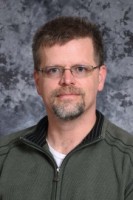Idaho Technology Improves Disposal of Radioactive Fracking Waste
By Joseph Campbell, INL
Idaho's nuclear expertise could soon bring benefits to America's fossil fuel industry. Hydraulic fracturing processes that are accessing vast U.S. natural gas resources can also carry an unwelcome side product from deep underground: naturally occurring radioactivity.
In the United States, oil and gas companies already have drilled nearly 1.2 million hydraulically fractured wells. Each well often produces significant amounts of Technologically Enhanced Naturally Occurring Radioactive Material (TENORM) that must be characterized, sorted, and disposed of properly. This process is time-consuming, expensive, and requires environmentally safe disposal practices.
Idaho National Laboratory researchers Doug Akers and Lyle Roybal developed the patent-pending Integrated Waste Screen System (IWSS) based on previous INL expertise for characterizing radioactive materials. In August, the scientists won the Outstanding Technology Development award from the Federal Laboratory Consortium Far West Region. This award is given to a laboratory and staff each year for a promising technology development to solve problems, satisfy markets and consumers, and create patents and awards.
The IWSS technology can efficiently assess the nearly 40 million tons of drilling waste generated by U.S. fractured wells. The system works on-site, providing three-minute analyses as well as a cost-reducing approach to certify that the waste is being safely disposed. The system can be adjusted to meet the needs and regulations of each project.
By documenting and certifying the sample material tracking process, the system helps operators, regulators, and subcontractors manage proper disposal of the waste. Operation of IWSS does not require extensive or taxing training; operators can be trained to analyze the data in just one day. IWSS costs an affordable $200 per ton to operate and could reduce shipping and disposal of materials by up to 75 percent.
The INL scientists developed IWSS with several specific goals:
- Segregate nonradioactive, low-level, and high-level TENORM wastes for proper disposal
- Characterize TENORM wastes during production
- Transport and dispose of the drilling waste
- Characterize existing TENORM waste sites to assess inventories for needed remediation
- Characterize surface soils around well drilling and waste sites to assess contamination levels and remediation requirements.
The IWSS system leverages decades of radioactive measurement technologies developed for the Department of Energy and the Nuclear Regulatory Commission. IWSS consists of a culmination of new intellectual property, involving specialized hardware tools and software protocols developed at INL during the past four decades.
Because the IWSS system can be quickly implemented and used in geographically remote oil and gas fields, it addresses challenges for the oil and gas industry, state environmental agencies, insurance liability, and an environmentally conscious public.
A preferred licensee for commercialization has been identified, and negotiations for an exclusive U.S. license are being finalized. Following licensing, IWSS will be available for widespread commercial use.
 Joe Campbell is a nuclear science and technology communicator with Idaho National Laboratory. He will be attending his first ANS Winter Conference in November-stop by the INL exhibit to say hello!
Joe Campbell is a nuclear science and technology communicator with Idaho National Laboratory. He will be attending his first ANS Winter Conference in November-stop by the INL exhibit to say hello!

